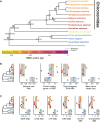Shared Features Underlying Compact Genomes and Extreme Habitat Use in Chironomid Midges
- PMID: 38662498
- PMCID: PMC11076180
- DOI: 10.1093/gbe/evae086
Shared Features Underlying Compact Genomes and Extreme Habitat Use in Chironomid Midges
Abstract
Nonbiting midges (family Chironomidae) are found throughout the world in a diverse array of aquatic and terrestrial habitats, can often tolerate harsh conditions such as hypoxia or desiccation, and have consistently compact genomes. Yet we know little about the shared molecular basis for these attributes and how they have evolved across the family. Here, we address these questions by first creating high-quality, annotated reference assemblies for Tanytarsus gracilentus (subfamily Chironominae, tribe Tanytarsini) and Parochlus steinenii (subfamily Podonominae). Using these and other publicly available assemblies, we created a time-calibrated phylogenomic tree for family Chironomidae with outgroups from order Diptera. We used this phylogeny to test for features associated with compact genomes, as well as examining patterns of gene family evolution and positive selection that may underlie chironomid habitat tolerances. Our results suggest that compact genomes evolved in the common ancestor of Chironomidae and Ceratopogonidae and that this occurred mainly through reductions in noncoding regions (introns, intergenic sequences, and repeat elements). Significantly expanded gene families in Chironomidae included biological processes that may relate to tolerance of stressful environments, such as temperature homeostasis, carbohydrate transport, melanization defense response, and trehalose transport. We identified several positively selected genes in Chironomidae, notably sulfonylurea receptor, CREB-binding protein, and protein kinase D. Our results improve our understanding of the evolution of small genomes and extreme habitat use in this widely distributed group.
Keywords: extremophile; gene family evolution; genome compaction; positive selection; repeat elements.
© The Author(s) 2024. Published by Oxford University Press on behalf of Society for Molecular Biology and Evolution.
Figures



References
-
- Armitage PD, Cranston PS, Pinder LCV. The chironomidae. The biology and ecology of non-biting midges. London, UK: Chapman & Hall; 1995.
-
- Benton MJ, Donoghue PCJ, Asher RJ. Calibrating and constraining molecular clocks. In: Hedges SB, Kumar S, editors. The timetree of life. New York, NY, USA: Oxford University Press; 2009. p. 35–86.
Publication types
MeSH terms
LinkOut - more resources
Full Text Sources

